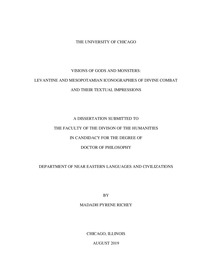Despite widespread agreement that narratives of divine combat with monstrous antagonists were politically and culturally important in the ancient Near East, scholars have not thoroughly explored how this importance can be demonstrated beyond the textual realm. This question is important in light of two central considerations in ancient Near Eastern studies. First, a model according to which communities primarily encountered narratives of divine combat through ritual recitation and performance has been rightly minimized or even set aside entirely. Second, the familiarity of non- or minimally literate individuals with ancient Near Eastern literary texts is no longer so readily assumed as in older scholarship. In order to examine whether narratives of divine combat were truly as politically and culturally significant as scholars claim, I examine first-millennium Mesopotamian and Levantine visual art along with textual sources that depict and describe both miniaturized and monumentalized divine combat. In doing so, I show that encounters with and reflections on depicted divine combat were frequent and deep. In exploring both visual art and textual data, I emphasize monster theoretical approaches to understand the ways in which depictions of combatted and subjugated monsters constitute the hegemony and normativity of victorious gods and, often through them, human terrestrial powers. I critically analyze two categories of first-millennium Mesopotamian data, namely cylinder seals and monumental statuary and reliefs depicting hybrid creatures. Lastly, I turn to Hebrew Bible figures that have been argued to reflect monumentalized cosmic antagonists: Neḥuštan (Num 21:4b–9a; 2 Kgs 18:4), the “molten sea” (1 Kgs 7:23–26; 2 Chr 4:2), and Goliath’s head (1 Sam 17:54). I argue that the first two of these have been erroneously understood and that the latter is the most promising locus for identifying southern Levantine textual interaction with the discourse of monumentalized monstrosity. In both Mesopotamia and the Levant, the depiction of a monster or of a divine figure overcoming a monster were primary means by which individuals encountered and recollected narratives of divine combat, and they are therefore of central importance for reconstructing the ways in which populaces received and engaged these core religious images.
Wednesday, January 18, 2023
Visions of Gods and Monsters: Levantine and Mesopotamian Iconographies of Divine Combat and Their Textual Impressions
Subscribe to:
Post Comments (Atom)






No comments:
Post a Comment